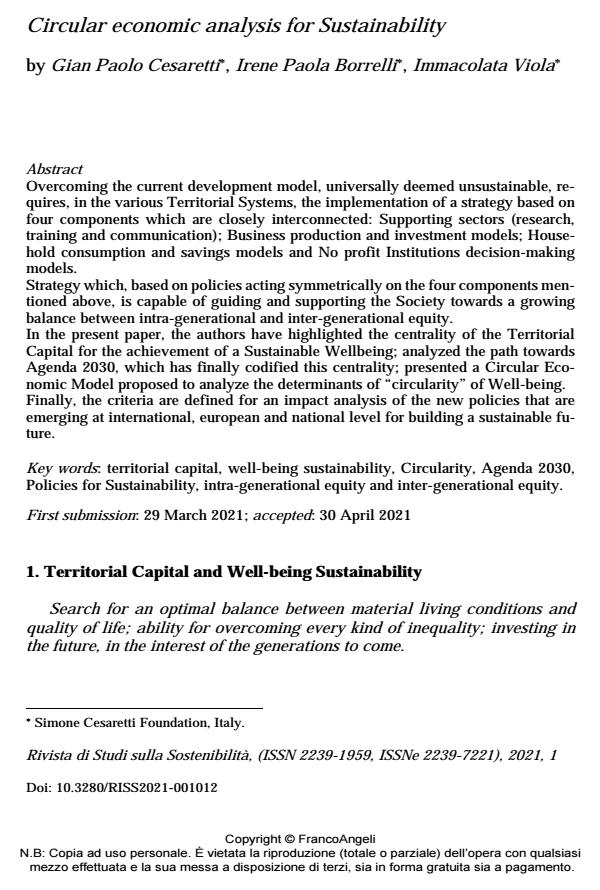Circular economic analysis for Sustainability
Journal title RIVISTA DI STUDI SULLA SOSTENIBILITA'
Author/s Gian Paolo Cesaretti, Irene Paola Borrelli, Immacolata Viola
Publishing Year 2021 Issue 2021/1
Language English Pages 21 P. 201-221 File size 1052 KB
DOI 10.3280/RISS2021-001012
DOI is like a bar code for intellectual property: to have more infomation
click here
Below, you can see the article first page
If you want to buy this article in PDF format, you can do it, following the instructions to buy download credits

FrancoAngeli is member of Publishers International Linking Association, Inc (PILA), a not-for-profit association which run the CrossRef service enabling links to and from online scholarly content.
Overcoming the current development model, universally deemed unsustainable, requires, in the various Territorial Systems, the implementation of a strategy based on four components which are closely interconnected: Supporting sectors (research, training and communication); Business production and investment models; Household consumption and savings models and No profit Institutions decision-making models. Strategy which, based on policies acting symmetrically on the four components mentioned above, is capable of guiding and supporting the Society towards a growing balance between intra-generational and inter-generational equity. In the present paper, the authors have highlighted the centrality of the Territorial Capital for the achievement of a Sustainable Wellbeing; analyzed the path towards Agenda 2030, which has finally codified this centrality; presented a Circular Economic Model proposed to analyze the determinants of "circularity" of Well-being. Finally, the criteria are defined for an impact analysis of the new policies that are emerging at international, european and national level for building a sustainable future.
Keywords: territorial capital, well-being sustainability, Circularity, Agenda 2030, Policies for Sustainability, intra-generational equity and inter-generational equity.
- Public Management of Railway Transport Development based on the Principles of a Systematic Approach Volodymyr Dykan, Olena Kirdina, Viktoria Ovchynnikova, Natalia Kalicheva, Hanna Obruch, in Scientific Horizons /2021 pp.98
DOI: 10.48077/scihor.24(8).2021.98-107 - Transition towards Well-being Sustainability:Approach to "Circular Economic Model" Nicola Marinelli, Gian Paolo Cesaretti, Immacolata Viola, in RIVISTA DI STUDI SULLA SOSTENIBILITA' 2/2022 pp.263
DOI: 10.3280/RISS2021-002019
Gian Paolo Cesaretti, Irene Paola Borrelli, Immacolata Viola, Circular economic analysis for Sustainability in "RIVISTA DI STUDI SULLA SOSTENIBILITA'" 1/2021, pp 201-221, DOI: 10.3280/RISS2021-001012